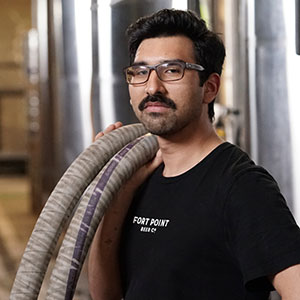

Ask Felipe Bravo how he got into brewing, and he’ll tell you it’s really quite simple.
“Well, I studied electrical engineering,” he says matter-of-factlythe inflection of his voice suggesting that, at least to him, the answer is painfully obvious.
After Bravo earned his bachelor’s from Cal Poly he dilly-dallied for a few years, working on satellite technology at a Palo Alto company. But then he did the sensible thing.
He went back to San Luis Obispo for his master’s, worked his way through most of his thesis projectdesigning the software and building the sensors for an automated home-brewing rigand then dropped out to work at a brewery, where he earned his stripes washing kegs for $10 an hour.
Today the San Jose native is production manager of research and development for the Fort Point Beer Company in San Francisco. He spends much of his free time working on what he calls the “Fox Tale Fermentation Project”in a garage just north of downtown San Jose. There, he and his fiancé, Wendy Neff, cook up their own beer recipes.
In 2018, the couple took first place in the Silicon Valley Homebrew Competition hosted by Hapa’s Brewing Company. Hapa’s rewarded them by producing a batch of their Sonic Bloom West Coast IPA and serving it at their taproom on Lincoln Avenue.
Looking back, Bravo says it really does make sense. “It’s funny,” he says. “I’ve been a brewer longer than I’ve been an engineer. But if it wasn’t for engineering, I would have never been a brewer.”
Bravo says he fell in love with brewing because it satisfied his creative needs while incorporating his scientific side. “It was something I could control,” he explains. “It was something that I could visualize and design and have a product that was truly mine.”
One could say that visualization is the cornerstone of Bravo’s job. It is his responsibility to ensure the consistency of Fort Point’s beer. Consumers may take it for granted, but it is no small feat for a brewery to reliably churn out a product that possesses the same flavor profile and alcohol content month after month, year after year. To accomplish this, Bravo puts his faith in the data.
On a recent afternoon, chatting over sandwiches near St. James Park, he whips out his phone and pulls up a series of spreadsheets he’s created. It looks a bit like a periodic tablea jigsaw puzzle of rectangular cells, each populated by numbers, decimal points, percentage symbols and terminology ripped from the glossary of a chemistry textbook.
It’s an English major’s worst nightmare.
Bravo uses this spreadsheet to track the four basic elements of beer: water, yeast, grain and hops. Taken at face value, this quartet of ingredients may seem simple enough. However, once they begin to interact, the potential outcomes multiply exponentially, splintering into a multiverse of possibility.
Take, for example, the most straightforward of the four: water. The Fort Point brewery is located in the Presidio in San Francisco. Like most of the city, Fort Point gets water from the Hetch Hetchy Reservoir. However, in the Presidio, Lobos Creek is also a large source of potable water. And even if Fort Point could rely on 100 percent Hetch Hetchy water 100 percent of the time, there would still be fluctuations in minerality.
“Beer is mostly water, so it contributes to all the flavors down the line,” Bravo explains. “You don’t always know when the water is going to be changing on you.”
Fort Point uses a charcoal filtration system in order to ensure a certain level of consistency in the water it uses for brewing, but that can’t guarantee a completely neutral Ph of 7. For that, they would need a reverse osmosis filtration system, like the one used by Camino Brewing, Floodcraft Brewing Company and other breweries in San Jose (see page 22). However, since minerals add flavors and characteristics that are often desirable, those same breweries will frequently reintroduce the very elements they have first eliminated later in the brewing process.
Bravo and his crew are constantly testing the water’s Ph levels and plugging the readings they get into his formulas to make adjustments.
A similar process is applied to the yeast. “Even if it is technically the same yeast strain, yeast can degrade over time if you don’t keep it healthy,” Bravo says. “Understanding yeast health is a major factor.” It is also important to know how much yeast is in a given brewthat is to say how many individual cells of yeast are swimming around in the mash, eating sugars and producing alcohol.
There was a time, not long ago, when breweries would perform “live cell counts” of yeastliterally putting a single milliliter of dyed, yeast-filled solution onto a specialized microscope slide called a hemocytometer. The slide, first developed to count blood cells, allows the observer to count microscopic elements in a defined area in order to come away with a representative sample.
There are now specialized, software-powered sensors that can perform this task, so brewers don’t have to crane their necks over a microscope to get a yeast count. But reliable yeast counts are still essential to the process of calibrating each batch of beer.
“Brewing beers at scale is all about consistency,” he says. “When you’re brewing at the scale that we brew at, that’s pretty hard. You have to be a really fucking good scientist to be a brewer.”
To sample the flavor of Bravo’s spreadsheet, head to the Fort Point on the Patio eventpart of Silicon Valley Beer Weekon Jul. 23.
Fort Point on the Patio
Jul 23, 5pm-9pm
Steins Beer Garden, Cupertino
svbeerweek.com



